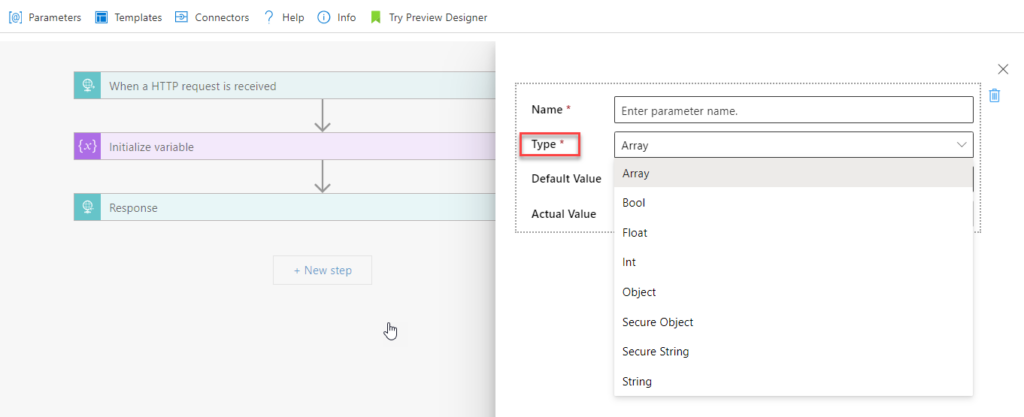In Azure Logic Apps, you can abstract values that might change in workflows across development, test, and production environments by defining parameters. A Logic App parameter stores values that can be reused throughout a Logic App workflow. These parameters allow for a more flexible and maintainable configuration of logic apps, making it easier to update values without changing the actual workflow’s logic.

Parameters can store various types of data, such as strings, secure strings, boolean, arrays, or any other data that might need to be used multiple times within the Logic App or may change based on the environment (development, test, production, etc.). They can also be defined at deployment time using CI/CD pipelines.

By using parameters, you can easily update these values in one place without needing to edit the logic in multiple actions or triggers throughout the app.
In practice, you define parameters in the Logic App’s definition and can then use them in expressions or directly in actions throughout the app. When the Logic App is deployed or executed, these parameters are evaluated and used accordingly. This approach helps you manage and deploy Logic Apps across different environments, making the workflows more dynamic and easier to configure.

The funny fact about parameters is that they are probably the only Logic App “component” that doesn’t have a size limit regarding the name. For example:
- Logic App Consumption name has a maximum limit of 80 characters.
- Logic App Standard Workflow name has a maximum limit of 43 characters
- A trigger or action name has a maximum limit of 80 characters.
- and so on.
But the Logic App parameter name is unlimited! To prove that and for fun, I have created a parameter with this name:
p_material_availability_changed_range_hours_assaasasasasasasasasassaassaaaaaaaaaaaaaaaaaaaaaaaaaaaaaaaaaaaaaaaaaaaaaaaaaaaaaaaaaaaaaaaaaaaaaaaaaaaaaaaaaaaaaaaaaaaasaaaaaaaaaaaaaaaaaaaaaaaaaaaaaaaaaassaasassaasasaaaaaaaaaaaaaaaaaaaaaaaaaaaaaaaaaaaaaaaassasasasasasaassasa_assaasasasasasasasasassaassaaaaaaaaaaaaaaaaaaaaaaaaaaaaaaaaaaaaaaaaaaaaaaaaaaaaaaaaaaaaaaaaaaaaaaaaaaaaaaaaaaaaaaaaaaaasaaaaaaaaaaaaaaaaaaaaaaaaaaaaaaaaaassaasassaasasaaaaaaaaaaaaaaaaaaaaaaaaaaaaaaaaaaaaaaaassasasasasasaassasa_assaasasasasasasasasassaassaaaaaaaaaaaaaaaaaaaaaaaaaaaaaaaaaaaaaaaaaaaaaaaaaaaaaaaaaaaaaaaaaaaaaaaaaaaaaaaaaaaaaaaaaaaasaaaaaaaaaaaaaaaaaaaaaaaaaaaaaaaaaassaasassaasasaaaaaaaaaaaaaaaaaaaaaaaaaaaaaaaaaaaaaaaassasasasasasaassasa_assaasasasasasasasasassaassaaaaaaaaaaaaaaaaaaaaaaaaaaaaaaaaaaaaaaaaaaaaaaaaaaaaaaaaaaaaaaaaaaaaaaaaaaaaaaaaaaaaaaaaaaaasaaaaaaaaaaaaaaaaaaaaaaaaaaaaaaaaaassaasassaasasaaaaaaaaaaaaaaaaaaaaaaaaaaaaaaaaaaaaaaaassasasasasasaassasa_assaasasasasasasasasassaassaaaaaaaaaaaaaaaaaaaaaaaaaaaaaaaaaaaaaaaaaaaaaaaaaaaaaaaaaaaaaaaaaaaaaaaaaaaaaaaaaaaaaaaaaaaasaaaaaaaaaaaaaaaaaaaaaaaaaaaaaaaaaassaasassaasasaaaaaaaaaaaaaaaaaaaaaaaaaaaaaaaaaaaaaaaassasasasasasaassasa


To be honest, I think this is crazy! They should fix this and set up a limit because giving that amount of power to developers (and I’m a developer, too) is insane, we can do some nasty stuff!
To lazy to read? We’ve got you covered! Check out our video version of this content!
Hope you find this helpful! If you enjoyed the content or found it useful and wish to support our efforts to create more, you can contribute towards purchasing a Star Wars Lego for my son!


